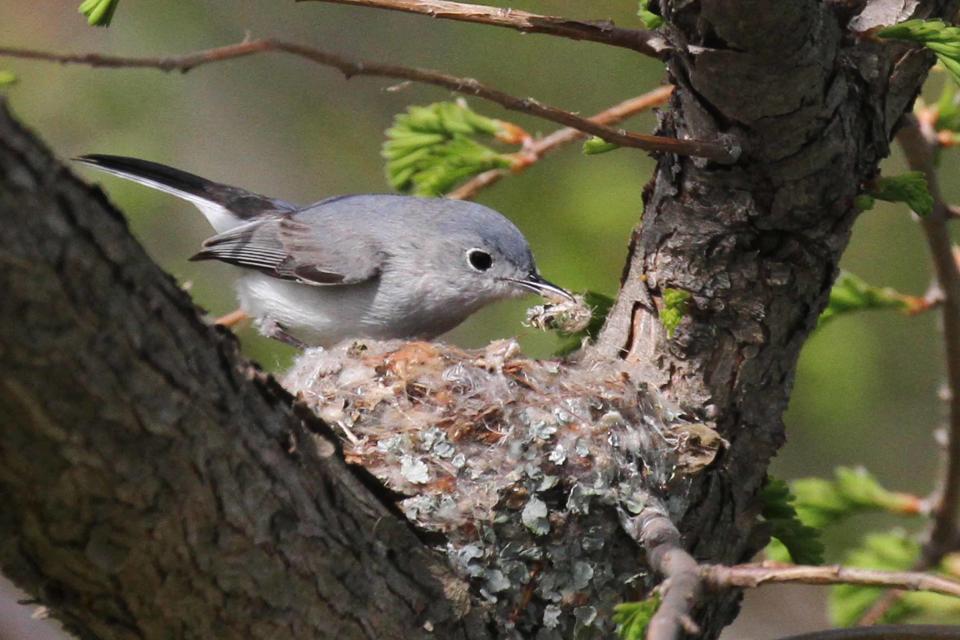Sorenson: Want to help your birds build a nest? Here's what to give them -- and what not to.
Most local resident birds start nest building as early as they deem doable. They grab prime territory before migrating summer nesters arrive, establish homestead rights by at least beginning a nest, and then guarding it with all their might.
Sometimes backyard hosts feel compelled to help birds with this big project, offering potential nesting materials. Recognizing the urge, marketers jumped in, offering balls, bales, and bundles of various so-called nesting materials.
Not only do the clever products ease the way for folks predetermined to help, they also suggest to folks who never gave it a thought that maybe it's the thing to do. Ka-ching!
But does offering nesting materials cause more harm than good? Which offerings are safe for nestlings? And − yikes! − which ones potentially kill the babies?

According to Cornell Lab of Ornithology, this nation's leading authority on all things bird related, there are some very specific do's and don'ts. Some of the don'ts will likely come as a surprise, given their history of acceptance:
DON'T supply drier lint. Sure, it's fluffy and seems perfect − to us. But when drier lint gets wet, it compacts and stays that way, never returning to its original fluff. Put in a nest, the lint causes the nest to sag, collapse, and dump eggs and babies out. They die.
DON'T supply pet hair. Sure, birds yank hair from wild animals and livestock, so pet hair seems a natural substitute. But we shampoo our pets, put toxic flea collars on them or otherwise treat them for biting insects like ticks. We caress our pets with our lotion-treated hands. All these residue contaminants can be deadly to hatchlings no bigger than a dime.
DON'T supply human hair. We, too, apply shampoos, conditioners, rinses, perhaps even tints, dyes, perms, and sprays. Toxic, all, to those tiny babies.
DON'T supply string, yarn, thread, ribbon, long hair, or anything else that ties. Squirmy nestlings frequently become entangled, the strands wrapped around their tiny but growing necks, wings, or legs, causing their slow, sometimes agonizing demise. Incubating adults have been found entangled as well.
DON'T use weed fabric. The loose thread-like strands at the ends attract birds that yank them loose. If they manage, putting the strands in nests results in the same danger as string and yarn.
Still, is there anything we can offer safely?
Indeed, there is. According to Cornell, "stick to natural items, such as moss, twigs, leaves, lichen, rootlets, or untreated grass clippings. If you have chickens or other poultry, their feathers may be used by some birds but be sure that the feathers have not had chemical treatments applied."
When we check what materials birds actually use, these are most common: dead twigs, weed/flower stems, dead/shredded leaves, plant fluff (like cottonwood and cattails), dry grass, straw, hay (without pesticides), mud, feathers, moss, lichens, bark strips, pine needles, and spider webs.
See the pattern? It's all natural. So skip the neat-and-tidy compulsion for your yard and leave the natural nesting materials in place. For your viewing pleasure, gather some, put them in mesh bags hung on posts or railings, pushed into tree crevices, tucked in clean suet cage, draped over vegetation, or offered In open-topped berry baskets.
Best of all? Offer safe, camouflaged, sheltered nest sites. Without these, no amount of nesting material serves any purpose.
For more information about birds and bird habitat, see Sharon Sorenson's books How Birds Behave, Birds in the Yard Month by Month, and Planting Native to Attract Birds to Your Yard. Follow daily bird activity on Facebook at SharonSorensonBirdLady, or email her at chshsoren@gmail.com.
This article originally appeared on Evansville Courier & Press: What stuff should I provide to a bird for nesting material?

